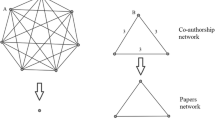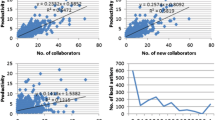Abstract
Many studies have tried to describe patterns of research collaboration through observing coauthorship networks. Those studies mainly analyze static networks, and most of them do not consider the development of networks. In this study, we turn our attention to the development of personal collaboration networks. On the basis of an analysis from two viewpoints, i.e., growth in the number of collaborating partners and change in the relationship strength with partners, we describe and compare the characteristics of four different domains, i.e., electrical engineering, information processing, polymer science, and biochemistry.
Similar content being viewed by others
References
Andersson, A. E., Persson, O. (1993), Networking scientists, Annals of Regional Science, 27(1): 11-21.
Arunachalam, S., Srinivasan, R., Raman, V. (1994), International collaboration in science: Participation by the Asian giants, Scientometrics, 30(1): 7-22.
Atkinson, A. B. (1970), On the measure of inequality, Journal of Economic Theory, 2(3): 244-263.
Baayen, R. H. (2001), Word Frequency Distributions, Dordrecht: Kluwer Academic Publishers.
Bird, J. E. (1997), Authorship patterns in marine mammal science, 1985–1993, Scientometrics, 39(1): 99-105.
Bordons, M., GÓmez, I. (2000), Collaboration networks in science, In: Web of Knowledge: A Festschrift in Honor of Eugene Garfield, pp. 197-213.
Cason, J. A. (1992), Authorship trends in poultry science, 1981 through 1990, Poultry Science, 71(8): 1283-1291.
Chitashvili, R. J., Baayen, R. H. (1993), Word frequency distributions, In: Quantitative Text Analysis, L. Hrebicek, G. Altmann (Eds), Trier: Wissenschaftlicher Verlag, pp. 54-135.
Cunningham, S. J., Dillon, S. M. (1997), Authorship patterns in information systems, Scientometrics, 39(1): 19-27.
Devilliers, F. P. R. (1984), Publish or perish: The growing trend towards multiple authorship, South African Medical Journal, 66(23): 882-883.
Drenth, J. P. H. (1998), Multiple authorship: The contribution of senior authors, Journal of the American Medical Association, 280(3): 219-221.
Egghe, L. (2002), Sampling and concentration values of incomplete bibliographies, Journal of the American Society for Information Science and Technology, 53(4): 271-281.
Elalami, J., Dore, J. C., Miquel, J. F. (1992), International scientific collaboration in Arab countries, Scientometrics, 23(1): 249-263.
Good, I. J. (1953), The population frequencies of species and the estimation of population parameters, Biometrika, 40(3–4): 237-264.
Good, I. J., Toulmin, G. H. (1956), The number of new species, and the increase in population coverage, when a sample is increased, Biometrika, 43(1): 45-63.
Herfindahl, O. C. (1950), Concentration in the Steel Industry, PhD thesis. New York: Columbia University.
Kageura, K. (1998), Some characteristics of bibliometric samples: An examination of Lotka-type data, Annals of Japan Society of Library Science, 44(3): 97-110.
Kretschmer, H., Gupta. B. M. (1998), Collaboration patterns in theoretical population genetics, Scientometrics, 43(3): 455-462.
Kundra, R., Kretschmer, H. (1999), A new model of scientific collaboration Part 2: Collaboration patterns in Indian medicine, Scientometrics, 46(3): 519-528.
Munoz, W. P., Moore, P. J. (1985), Multiple authorship, South African Medical Journal, 68(6): 368.
Narin, F., Stevens, K., Whitlow E. S. (1991), Scientific cooperation in Europe and the citation of multinationally authored papers, Scientometrics, 21(3): 313-323.
Okubo, Y., Miquel, J. F., Frigoletto, L., Dore, J. C. (1992), Structure of international collaboration in science: Typology of countries through multivariate techniques using a link indicator, Scientometrics, 25(2): 321-351.
O'Neill, G. P. (1998), Authorship patterns in theory based versus research based journals, Scientometrics, 41(3): 291-298.
Otte, E., Rousseau, R. (2002), Social network analysis: A powerful strategy, also for the information sciences, Journal of Information Science, 28(6): 441-453.
Pratt, A. D. (1977), A measure of class concentration in bibliometrics, Journal of the American Society for Information Science, 28(5): 285-292.
Ray, J. L., Singer, J. D. (1973), Measuring the concentration of power in the international system, Sociological Methods & Research, 1(4): 403-437.
Sacco, W. P., Milana, S. (1984), Increase in number of authors per article in 10 APA journals: 1960–1980, Cognitive Therapy and Research, 8(1): 77-83.
Theil, H. (1967), Economic and Information Theory, Amsterdam: North-Holland Publishing Company.
Tweedie, F. J., Baayen, R. H. (1998), How variable may a constant be?: Measures of lexical richness in perspective, Computers and the Humanities, 32: 323-352.
Wasserman, S., Faust, K. (1994), Social Network Analysis, New York: Cambridge University Press.
Yitzhaki, M., Ben-Tamar, D. (1990), Multiple authorship in biochemistry and other fields: A case study of the Journal of Biological Chemistry throughout 1905–1988, In: Informetrics, 89/90, L. Egghe, R. Rousseau (Eds), Amsterdam: Elsevier, pp. 373-389.
Yoshikane, F. (2000), Concentration in bibliometric distributions: The notion of concentration and concentration measures, Journal of Japan Society of Library and Information Science, 46(1): 18-32.
Yoshikane, F., Kageura, K., Tsuji, K. (2003), A method for the comparative analysis of concentration of author productivity, giving consideration to the effect of sample size dependency of statistical measures, Journal of the American Society for Information Science and Technology, 54(6): 521-528.
Author information
Authors and Affiliations
Rights and permissions
About this article
Cite this article
Yoshikane, F., Kageura, K. Comparative analysis of coauthorship networks of different domains: The growth and change of networks. Scientometrics 60, 435–446 (2004). https://doi.org/10.1023/B:SCIE.0000034385.05897.46
Issue Date:
DOI: https://doi.org/10.1023/B:SCIE.0000034385.05897.46




